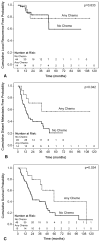The role of consolidation therapy for stage III non-small cell lung cancer with persistent N2 disease after induction chemotherapy
- PMID: 22819472
- PMCID: PMC3468148
- DOI: 10.1016/j.athoracsur.2012.04.088
The role of consolidation therapy for stage III non-small cell lung cancer with persistent N2 disease after induction chemotherapy
Abstract
Background: Persistent pathologic mediastinal nodal involvement after induction chemotherapy and surgical resection is a negative prognostic factor for stage III-N2 non-small cell lung cancer patients. This population has high rates of local-regional failure and distant failure, yet the effectiveness of additional therapies is not clear. We assessed the role of consolidative therapies (postoperative radiation therapy and chemotherapy) for such patients.
Methods: In all, 179 patients with stage III-N2 non-small cell lung cancer at MD Anderson Cancer Center were treated with induction chemotherapy followed by surgery from 1998 through 2008; 61 patients in this cohort had persistent, pathologically confirmed, mediastinal nodal disease, and were treated with postoperative radiation therapy. Local-regional failure was defined as recurrence at the surgical site or lymph nodes (levels 1 to 14, including supraclavicular), or both. Overall survival was calculated using the Kaplan-Meier method, and survival outcomes were assessed by log rank tests. Univariate and multivariate Cox proportional hazards models were used to identify factors influencing local-regional failure, distant failure, and overall survival.
Results: All patients received postoperative radiation therapy after surgery, but approximately 25% of the patients also received additional chemotherapy: 9 (15%) with concurrent chemotherapy, 4 (7%) received adjuvant sequential chemotherapy, and 2 (3%) received both. Multivariate analysis indicated that additional postoperative chemotherapy significantly reduced distant failure (hazard ratio 0.183, 95% confidence interval: 0.052 to 0.649, p=0.009) and improved overall survival (hazard ratio 0.233, 95% confidence interval: 0.089 to 0.612, p=0.003). However, additional postoperative chemotherapy had no affect on local-regional failure.
Conclusions: Aggressive consolidative therapies may improve outcomes for patients with persistent N2 disease after induction chemotherapy and surgery.
Copyright © 2012 The Society of Thoracic Surgeons. Published by Elsevier Inc. All rights reserved.
Figures
Comment in
-
Invited commentary.Ann Thorac Surg. 2012 Sep;94(3):920-1. doi: 10.1016/j.athoracsur.2012.05.076. Ann Thorac Surg. 2012. PMID: 22916752 No abstract available.
-
Current readings: management of N2 disease for lung cancer.Semin Thorac Cardiovasc Surg. 2014 Spring;26(1):67-70. doi: 10.1053/j.semtcvs.2014.02.008. Epub 2014 Feb 27. Semin Thorac Cardiovasc Surg. 2014. PMID: 24952759
References
-
- Robinson LA, Ruckdeschel JC, Wagner H, Stevens CW. Treatment of non-small cell lung cancer-stage IIIA: ACCP evidence-based clinical practice guidelines (2nd edition) Chest. 2007;132(Suppl):243– 65. - PubMed
-
- Dautzenberg B, Arriagada R, Chammard AB, et al. A controlled study of postoperative radiotherapy for patients with completely resected nonsmall cell lung carcinoma. Cancer. 1999;86:265–73. - PubMed
-
- Stephens RJ, Girling DJ, Bleehen NM, Moghissi K, Yosef HM, Machin D. The role of post-operative radiotherapy in non-small-cell lung cancer: a multicentre randomised trial in patients with pathologically staged T1-2, N1-2, M0 disease. Medical Research Council Lung Cancer Working Party. Br J Cancer. 1996;74:632–9. - PMC - PubMed
-
- Feng QF, Wang M, Wang LJ, et al. A study of postoperative radiotherapy in patients with non-small-cell lung cancer: a randomized trial. Int J Radiat Oncol Biol Phys. 2000;47:925–9. - PubMed
Publication types
MeSH terms
Grants and funding
LinkOut - more resources
Full Text Sources
Medical


